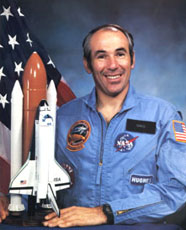GREGORY B. JARVIS (MR.)
NASA ASTRONAUT

PERSONAL DATA: Born August 24, 1944, in Detroit, Michigan. He is survived by his wife, Marcia. Greg Jarvis was an avid squash player and bicycle rider. He also enjoyed cross country skiing, backpacking, racquet ball, and white water river rafting. For relaxation, he played the classical guitar.
EDUCATION: Graduated from Mohawk Central High School, Mohawk, New York, 1962; received a bachelor of science degree in electrical engineering, State University of New York at Buffalo, 1967; a masterís degree in electrical engineering, Northeastern University, Boston, Massachusetts, 1969. Mr. Jarvis also completed all of the course work for a masterís degree in management science, West Coast University, Los Angeles, California.
EXPERIENCE: While pursuing his masterís degree at Northeastern, Mr. Jarvis worked at Raytheon in Bedford Massachusetts, where he was involved in circuit design on the SAM-D missile. In July 1969, he entered active duty in the Air Force and was assigned to the Space Division in El Segundo, California. As a Communications Payload Engineer, in the Satellite Communications Program Office, he worked on advanced tactical communications satellites. He was involved in the concept formulation, source selection, and early design phase of the FLTSATCOM communications payload. After being honorably discharged from the Air Force in 1973, with the rank of Captain, he joined Hughes Aircraft Companyís Space and Communications group, where he worked as a Communications Subsystem Engineer on the MARISAT Program. In 1975, he became the MARISAT F-3 Spacecraft Test and Integration Manager. In 1976, the MARISAT F-3 was placed in geosynchronous orbit. Jarvis became a member of the Systems Applications Laboratory in 1976, and was involved in the concept definition for advanced UHF and SHF communications for the strategic forces. Joining the Advanced Program Laboratory in 1978, he began working on the concept formulation and subsequent proposal for the SYNCON IV/LEASAT Program. In 1979, he became the Power/Thermal/Harness Subsystem Engineer on the LEASAT Program. In 1981, he became the Spacecraft Bus System Engineering and in 1982, the Assistant Spacecraft System Engineering Manager. He was the Test and Integration Manager for the F-1, F-2, and F-3 spacecraft and the cradle in 1983, where he worked until the shipment of the F-1 spacecraft and cradle to Cape Kennedy for integration into the Orbiter. Both the F-1 and F-2 LEASAT spacecraft have successfully achieved their geosynchronous positions. Mr. Jarvis worked on advanced satellite designs in the Systems Application Laboratory. He was selected as a payload specialist candidate in July 1984.
NASA EXPERIENCE: Mr. Jarvis was a payload specialist on STS 51-L which was launched from the Kennedy Space Center, Florida, at 11:38:00 EST on January 28, 1986. The crew on board the Orbiter Challenger included the spacecraft commander, Mr. F.R. Scobee, the pilot, Commander M.J. Smith (USN), mission specialists, Dr. R.E. McNair, and Lieutenant Colonel E.S. Onizuka (USAF), and fellow civilian payload specialist, Mrs. S. C. McAuliffe. The STS 51-L crew died on January 28, 1986 when Challenger exploded after launch.






